This post may contain affiliate links. Please see our disclosure policy.
Dill Pickle Spears are a delicious way to preserve cucumbers in season, and there’s nothing like a homemade pickle next to your lunchtime sandwich to turn the ordinary into something special. This particular recipe is adapted from a tested pickle canning recipe by Ball Canning, but they can also be made as refrigerator pickles.
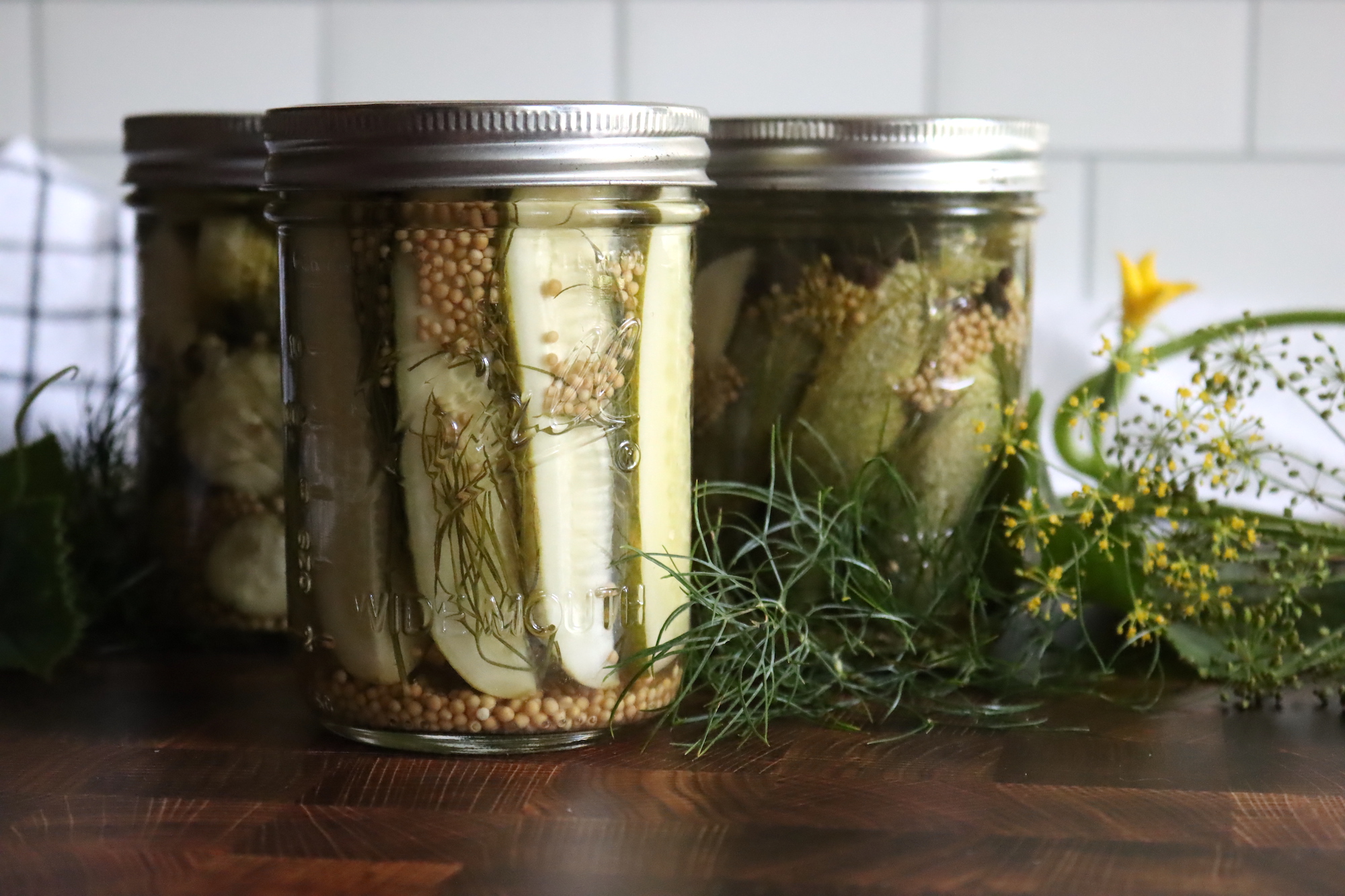
Mid-summer is cucumber season here on the homestead, and while there are dozens of ways to preserve cucumbers, homemade pickles are by far my favorite. We make bread and butter pickle slices and dill pickle slices for canning each year, and but this year I’m making more whole pickles and pickle spears for my pantry.
Our garden beds produce an abundance of cucumbers in all sizes, and we pick the teeny tiny ones for making French Cornichons (1 1/2 to 2 inches). A bit bigger, and they’re perfect for old-fashioned sweet gherkins (2 to 3 inches). Let them grow just a tiny bit more, and they’ll reach 3 to 5 inches, which is the perfect size for dill pickle spears.
Save those gigantic cucumbers that get lost under the leaves for old-fashioned fermented dill pickles if you’re ambitious, the kind they sell in barrels at old-time country stores. Don’t use the huge ones for pickle spears though, they’ll only lead to mushy pickles.
For the perfect crisp dill pickle spears, harvest 3 to 5-inch cucumbers and get them into the kitchen for pickle making that same day. (The fresher the better.)

Ingredients for Dill Pickle Spears
This recipe is a tested canning recipe for dill pickle spears, adapted from The All New Ball Book of Canning and Preserving (pg. 212). They have a number of pickling recipes in there, but this one’s specifically tailored to making dill pickle spears that fit perfectly into wide-mouth pint jars.
To make six wide-mouth pint jars of dill pickle spears, you’ll need the following:
For the Cucumber Pre-Soak:
- 4 lbs. pickling cucumbers, 3 to 5 inches long
- 6 Tbsp. canning Salt
- 1-gallon water
Packed into jars:
- Trimmed, soaked cucumbers
- 12 fresh dill sprigs (or 6 tsp. dried dill seeds)
- 6 tsp. whole mustard seeds
- pickle crisp (1/8 tsp. per pint, optional)
Pickling Brine:
- 1 quart water
- 3 cups white vinegar (5% acidity)
- 1/4 cup canning salt (or kosher salt)
- 2 Tbsp. sugar
- 1 Tbsp. Pickling Spice (see note)
If you measure in kilograms instead of pounds, that’s about 1.8 kg, and the cucumbers should be roughly 7.5 to 12.5 cm long.
Pickling spice mixes usually include whole allspice, coriander, mustard seeds, and cloves, along with broken or crumbled bay leaves and cinnamon sticks. They also sometimes include ginger or red pepper flakes for heat.
You can use a prepared pickling spice mix or make your own. You can also just toss in a pinch of each of the spices listed and call it good. When making pickles, the spice mix is totally up to you and does not impact canning safety. It’s totally just a flavor thing, and if you don’t like an ingredient in the pickling spice mix, just leave it out.
In this particular recipe, the cucumbers are soaked in salt water for 24 hours before they’re packed into jars, and that’s to keep them from tasting soggy. The saltwater soak really does make a difference when you’re making pickle spears, so don’t skip it!
Dill, mustard seeds and pickle crisp is added directly to each jar rather than adding it to the pickling brine. This ensures an even amount in each jar.
Pickle crisp is optional, but it helps firm the pickles. It’s Calcium chloride or just a calcium-based salt. The calcium helps strengthen the cell walls of the cucumbers and keeps them crisp during canning (and no, it doesn’t taste salty, it’s completely tasteless).
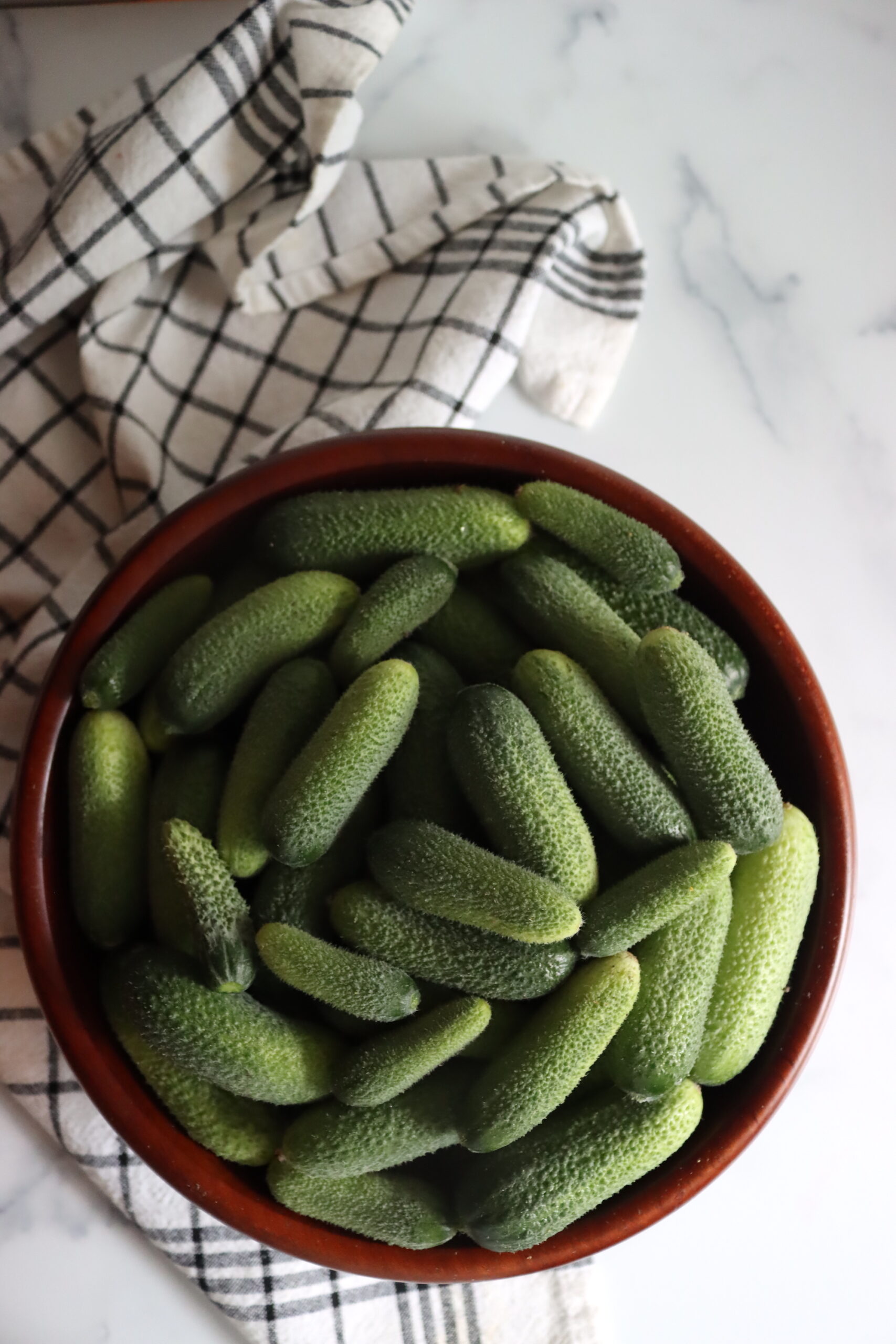
Preparing Cucumbers for Making Dill Pickle Spears
The preparations for these dill pickle spears is relatively simple, but it is important.
The cucumbers are washed, and gently scrubbed to remove their bumps. Next, they’re trimmed to size and cut vertically into quarters before being soaked in salt water for 24 hours.
The salt water soak is very important, and if you skip it, your dill pickle spears will be soggy (ask me how I know).
This initial soak also contributes a bit of salt to the finished pickles, but most of it is lost when you drain the water. The finished pickling bring also includes salt, but less than you’d want if you didn’t do the salt water soak.
If you’re using 3 to 5” cucumbers, you should be able to split them into quarters vertically and slip them easily into wide-mouth pints, leaving the required 1/2-inch headspace. As they get closer to 5”, you’ll need to nip off the bottom bit to make that work, since most pint canning jars have just a bit over 4 inches of usable space when you allow for the proper headspace.
Always cut off the blossom end, rather than the stem end.
The blossom end of the cucumber produces enzymes that can make the pickles soft, which are active even after canning. Most sources recommend trimming at least 1/16 of an inch off the blossom end of any cucumber before pickling, even when making whole pickles. If you’re making pickle spears and trying to fit them into jars, then go ahead and trim off a bit more until they’re the perfect length to fit into your canning jars, leaving 1/2 inch headspace.
Once the cucumbers are trimmed and split into quarters, place them in a large bowl and cover them with 6 Tablespoons of salt dissolved in 1 gallon of cold water.
Allow the pickle spears to soak in the cold salt water for 24 hours before proceeding.
How to Make Dill Pickle Spears
After the cucumbers have soaked, drain the water and pack the already trimmed pickle spears into wide-mouth pint mason jars leaving 1/2 inch headspace.
I really suggest using wide-mouth pints here, as it’s very difficult to pack pickle spears into narrow-mouth jars. You might also be tempted to use quart jars for really big pickles so you don’t have to trim them, but I don’t recommend that. Quart jars have a longer processing time in the canner, leading to mushy pickles.
Besides, you really want 3 to 5 inch cucumbers to make the best dill pickle sprears.
Add 1 tsp of mustard seeds and 2 dill sprigs to each jar. If you don’t have fresh dill, you can use 1 tsp dried dill seed for each jar instead.
Once the cucumber spears are packed into jars, prepare a water bath canner (if canning) and start making the pickling brine.
In a saucepan, add the following pickle brine ingredients:
- 1-quart water
- 3 cups white vinegar (5% acidity)
- 1/4 cup canning salt (or kosher salt)
- 2 Tbsp. sugar
- 1 Tbsp. Pickling Spice (see note)
Bring the mixture to a boil, stirring to dissolve the salt and sugar.
Pour the boiling pickle brine over the cucumber spears in the jars (reminder, there’s already dill sprigs and mustard seed in the jars too, along with pickle crisp, if you’re using it). Be sure to leave 1/2 inch headspace.
At this point, if you’re making refrigerator pickles, you simply cap the jars, let them cool, and then store them in the refrigerator for 1-2 weeks to allow them to pickle before enjoying them.
If you’re canning, proceed to the canning instructions below.
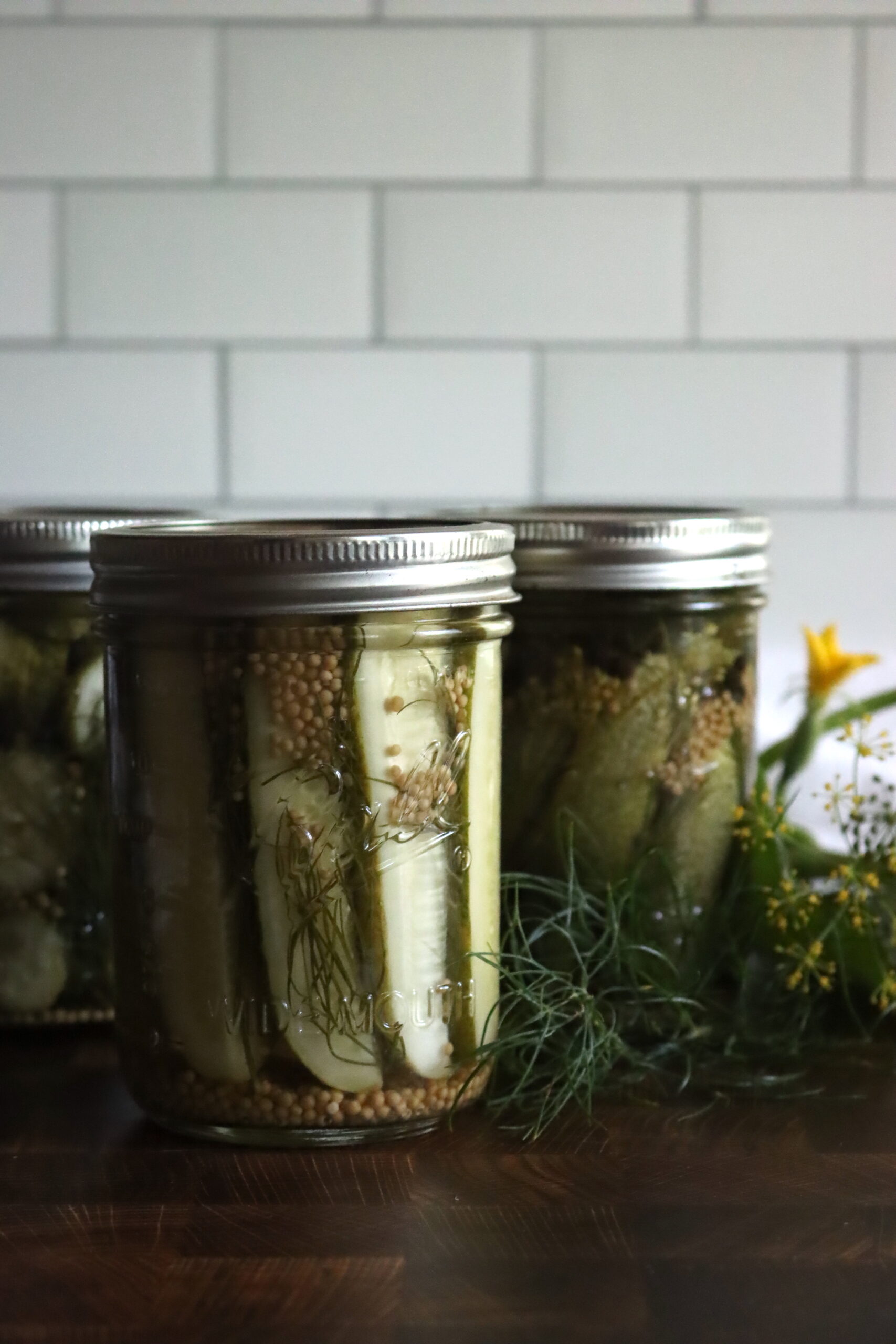
Canning Dill Pickle Spears
If canning, make sure that you’ve prepared and pre-heated a water bath canner to simmering before you start making the pickle brine.
Prepare the pickles as you otherwise would, but be extra sure that you leave 1/2 inch headspace. Too much (or to little) headspace and the jars may not seal.
Cap the jars with 2-part canning lids to finger tight and then use a jar lifter to load the jars into a water bath canner.
Bring the canner to a full rolling boil and process the jars for 10 minutes. Once 10 minutes is up, turn off the canner and allow the jars to partially cool in the canning water for another 5 minutes (this helps prevent siphoning or liquid loss as you pull them out of the canner).
Next, use a jar lifter to remove the jars from the canner and place them on a towel on the counter. Allow the jars to cool completely for 12-24 hours, then check seals. Store any unsealed jars in the refrigerator and use those first.
Properly canned and sealed jars of dill pickle spears will maintain peak quality on the pantry shelf for about 12 months, but they’ll be safe to eat so long as they’re still sealed. Refrigerate after opening.
Altitude Adjustments
The 10-minute canning time is for pint jars at or below 1,000 feet in elevation.
If you’re using quart jars, which I don’t recommend, the canning time is increased to 15 minutes below 1,000 feet in elevation.
For 1,000 feet to 6,000 feet, the canning time is 15 minutes for pints and 20 minutes for quarts. Above 6,000 feet, the canning time is 20 minutes for pints and 25 minutes for quarts.
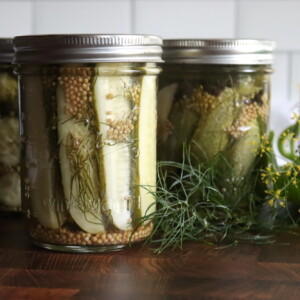
Dill Pickle Spears
Ingredients
For the Cucumber Pre-Soak:
- 4 lbs. pickling cucumbers, 3 to 5 inches long
- 6 Tbsp. canning Salt
- 1- gallon water
Packed into jars:
- Trimmed, soaked cucumbers from above
- 12 fresh dill sprigs, or 6 tsp. dried dill seeds
- 6 tsp. whole mustard seeds
- Pickle crisp, 1/8 tsp. per pint, optional
Pickling Brine
- 1 Quart water
- 3 cups white vinegar, 5% acidity
- 1/4 cup canning salt, or kosher salt
- 2 Tbsp. sugar
- 1 Tbsp. Pickling Spice, see note
Instructions
- Wash the cucumbers, gently scrubbing to remove any spines. Cut the cucumbers lengthwise into quarters to form spears.
- Dissolve 6 Tbsp. salt in 1 gallon of cold water.
- Place the cucumbers in a bowl and pour the cold salt water over them. Allow them to soak for 24 hours.
- Drain the soaking water and pack the cucumbers into wide-mouth pint jars. Trim off the cucumber if necessary to ensure they fit, leaving 1/2 inch headspace.
- Add 1 tsp mustard seeds and 2 dill sprigs to each jar. Lacking fresh dill sprigs, you can add 1 tsp dried dill seed to each jar instead. Add pickle crisp if using at a rate of 1/8 tsp per pint jar.
- At this point, prepare a water bath canner if canning.
- Make the pickle brine by bringing the brine ingredients to a boil in a pot, stirring to dissolve the sugar and salt.
- Pour the boiling brine over the top of the cucumbers in the jars, maintaining 1/2 inch headspace. Cap with 2 part lids.
- If making refrigerator pickles, allow the jars to cool completely before storing in the refrigerator.
- If canning, process the jars in a water bath canner for 10 minutes. Turn off the heat and allow the jars sit in the canner for an additional 5 minutes before removing them to cool completely on a towel on the counter.
- Wait 12-24 hours , then check seals. Store any unsealed jars in the refrigerator and use first.
- Properly canned and sealed jars of dill pickle spears will maintain peak quality on the pantry shelf for 12 months, and be safe to eat so long as they're sealed. Refrigerate after opening.
- For the best flavor, allow the jars to sit for at least 1-2 weeks before enjoying, so they have time to properly developed a pickled flavor.
Notes
Nutrition
Nutrition information is automatically calculated, so should only be used as an approximation.
Pickling Recipes
Looking for more simple pickling recipes?
- Pickled Corn Salad
- Pickled Three Bean Salad
- Pickled Green Tomatoes
- Pickled Green Beans (Dilly Beans)
- Pickled Jalapenos
- Pickled Fiddleheads
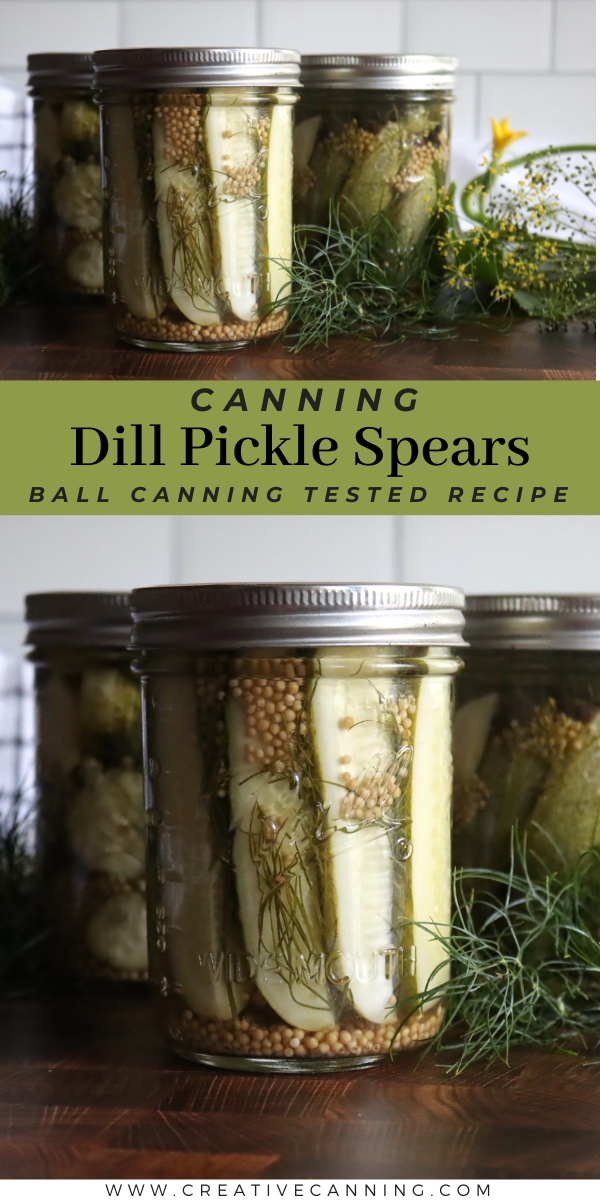
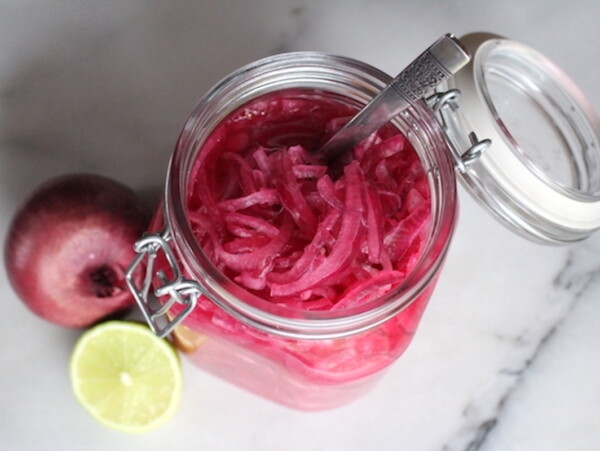
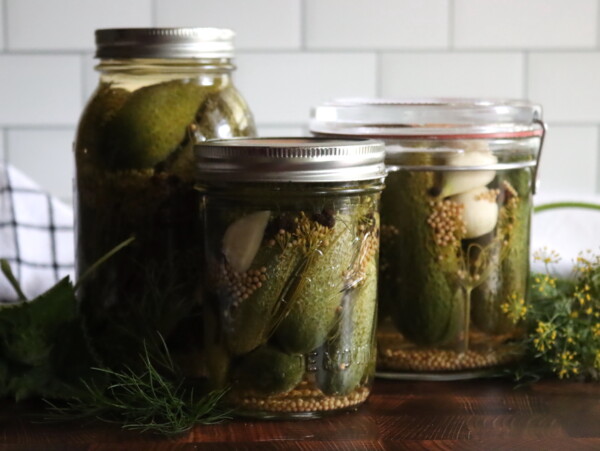

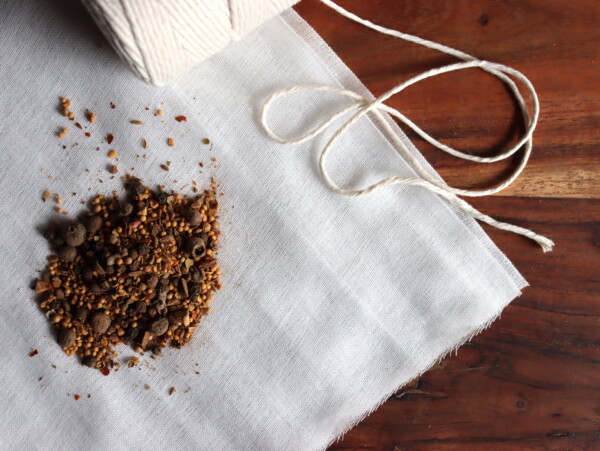
This recipe sounds really good. Wondering if it can be made with tiny cucumbers?
Of course! You can use any cucumber type in this recipe (or zucchini too!).
Great recipe!! Thank you
So glad you liked it!
Hi there. How long do they last if they haven’t been canned and are just in the fridge?
These should last many months in the fridge. Honestly, I’ve never had a fridge pickle go bad. Just make sure everything stays under the brine and in the fridge and it should be good.
Hello, I’ve just put the pickles into the salt water to soak for 24 hours. Do I put them in the fridge or is it ok to leave them on the countertop? This is my first time trying pickles, I just started canning a few weeks ago and I’m having so much fun! Can’t wait to try these, than you for the recipe.
Ideally, they’d go into the fridge because the cooler you keep cucumbers before they’re pickled, the crisper they’ll be. That said, I often don’t have room in the fridge and this is fine to leave out on the countertop (covered) for 24 hours in terms of food safety.
Can I use a sugar substitute like swerve instead of regular sugar for this recipe?
Yup, the sugar isn’t required for canning safety. If you have a canning safe sugar alternative, you can use that. I don’t use sugar alternatives, so I’m honestly not sure which specific brands are ok for canning, but I think most are allowed. Just try to double check on the brand you’re using. You can also do them without any sugar too.